Kolmogorov–Smirnov-Based Edge Centrality Measure for Metric Graphs
Abstract
1. Introduction
2. Metric Graphs
3. Vertex Centrality Measures
Edge Centrality Measures
4. Edge Centrality Measure for Metric Graphs
- Create a second metric graph, , by removing edge from .
- Calculate the energy density (see Equation (2)), , for each edge in each metric graph.
- Compute the average edge density, , for each edge for each metric graph.
- Normalize the average edge density for each edge for each metric graph by the total energy, .
- Apply the two-sample KS test on the two empirical CDFs of the normalized average edge densities to obtain a p-value.
- Compare the p-value to a chosen significance level ; if , then edge is concluded to have an influential role in the energy density distribution of .
5. Results
5.1. G14 Network
5.2. Road Network
6. Conclusions
Author Contributions
Funding
Data Availability Statement
Acknowledgments
Conflicts of Interest
Appendix A. Computational Complexity
- Phase 1. Given a metric graph , generate the graph ; this part is computationally trivial. Then, find the Helmholtz eigenvalues on and in range .
- Phase 2. Find the corresponding eigenvectors, calculate the average energy density over all eigensolutions, and run a KS test to compare the distributions.The time complexity of this computation depends on several factors:
- –
- Eigenvalue upper bound, M: Although the specific eigenvalues vary between graphs, at some point the energy density distribution stabilizes beyond a certain point. For instance, in the G14 network, the distributions for and are nearly indistinguishable.
- –
- Total length of the graph: The number of eigenvalues satisfying follows Weyl’s asymptotic estimate, growing aswhere L is the total length [55]. A graph with longer edge lengths contains more eigenvalues in the range , which necessitates a finer search grid to ensure accuracy. Additionally, more eigenvalues increase the number of integral evaluations and summation terms, further contributing to computational cost.
- –
- Choice of algorithm: Optimization strategies may improve computational efficiency, potentially at the cost of accuracy. Possible enhancements include leveraging the sparse structure of the matrix of junction conditions, exploiting known eigenvalue spacings, parallelization, and decreasing the error threshold.
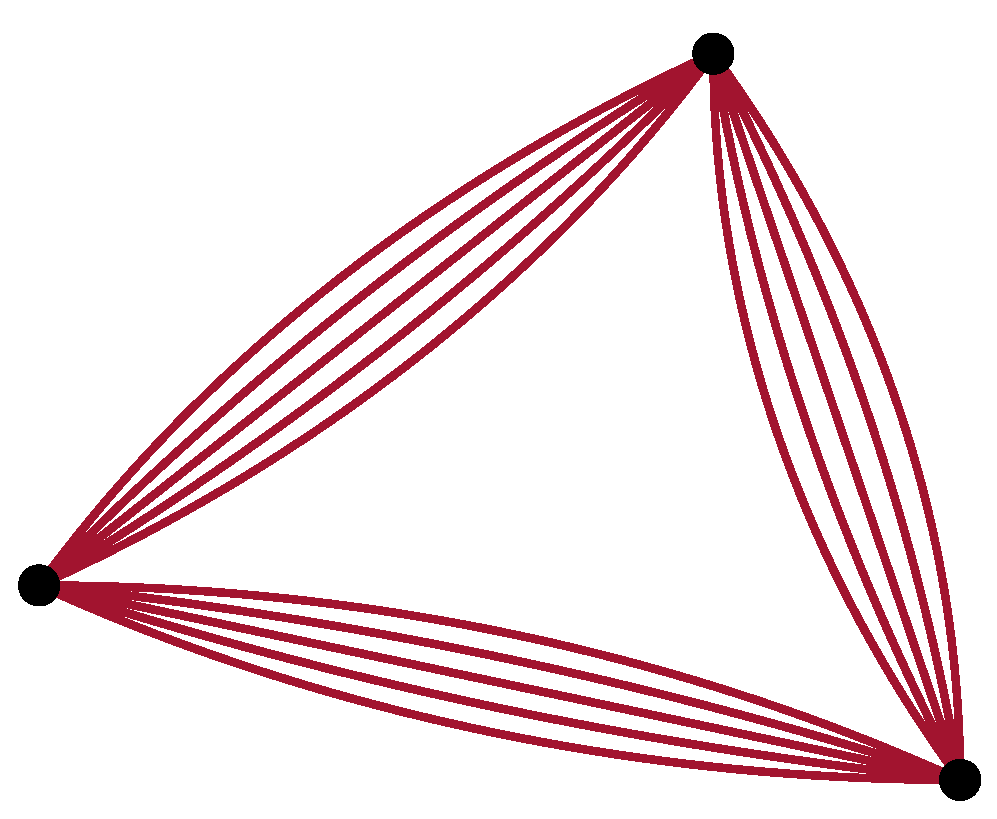
Appendix A.1. Phase I Complexity Analysis
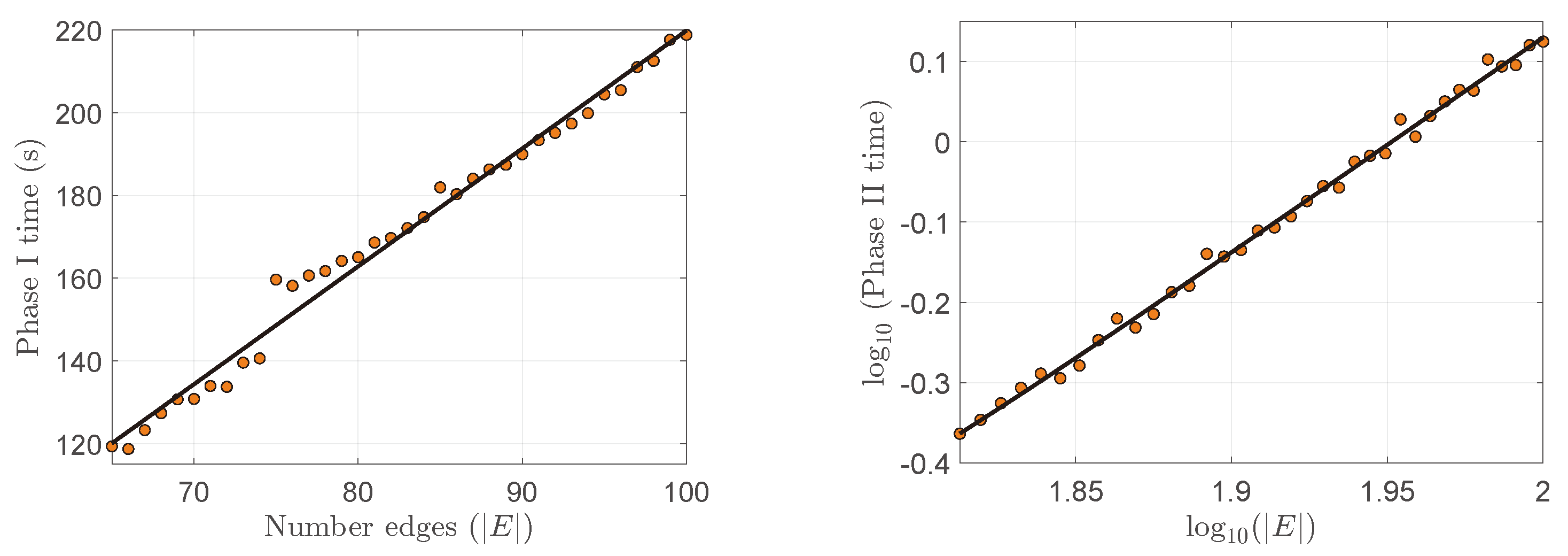
Appendix A.2. Phase II Complexity Analysis
References
- Strogatz, S.H. Exploring complex networks. Nature 2001, 410, 268–276. [Google Scholar] [CrossRef] [PubMed]
- Newman, M.E. The Structure and Function of Complex Networks. SIAM Rev. 2003, 45, 167–256. [Google Scholar] [CrossRef]
- Boccaletti, S.; Latora, V.; Moreno, Y.; Chavez, M.; Hwang, D.U. Complex networks: Structure and dynamics. Phys. Rep. 2006, 424, 175–308. [Google Scholar] [CrossRef]
- Rings, T.; Bröhl, T.; Lehnertz, K. Network structure from a characterization of interactions in complex systems. Sci. Rep. 2022, 12, 11742. [Google Scholar] [CrossRef]
- Freeman, L.C. Centrality in social networks: Conceptual clarification. In Social Network: Critical Concepts in Sociology; Routledge: London, UK, 2002; Volume 1, pp. 238–263. [Google Scholar]
- Bonacich, P.; Lloyd, P. Eigenvector-like measures of centrality for asymmetric relations. Soc. Netw. 2001, 23, 191–201. [Google Scholar] [CrossRef]
- Bavelas, A. Communication patterns in task-oriented groups. J. Acoust. Soc. Am. 1950, 22, 725–730. [Google Scholar] [CrossRef]
- Freeman, L.C. A Set of Measures of Centrality Based on Betweenness. Sociometry 1977, 40, 35–41. [Google Scholar] [CrossRef]
- Madotto, A.; Liu, J. Super-Spreader Identification Using Meta-Centrality. Sci. Rep. 2016, 6, 38994. [Google Scholar] [CrossRef]
- Durón, C. Heatmap centrality: A new measure to identify super-spreader nodes in scale-free networks. PLoS ONE 2020, 15, e0235690. [Google Scholar] [CrossRef]
- Kitsak, M.; Gallos, L.K.; Havlin, S.; Liljeros, F.; Muchnik, L.; Stanley, H.E.; Makse, H.A. Identification of influential spreaders in complex networks. Nat. Phys. 2010, 6, 888–893. [Google Scholar] [CrossRef]
- Borgatti, S.P. Centrality and network flow. Soc. Netw. 2005, 27, 55–71. [Google Scholar] [CrossRef]
- Holme, P.; Kim, B.J.; Yoon, C.N.; Han, S.K. Attack vulnerability of complex networks. Phys. Rev. E 2002, 65, 056109. [Google Scholar] [CrossRef]
- Crucitti, P.; Latora, V.; Marchiori, M. A topological analysis of the Italian electric power grid. Phys. A Stat. Mech. Appl. 2004, 338, 92–97. [Google Scholar] [CrossRef]
- Bullmore, E.; Sporns, O. Complex brain networks: Graph theoretical analysis of structural and functional systems. Nat. Rev. Neurosci. 2009, 10, 186–198. [Google Scholar] [CrossRef]
- Allen, R.J.; Elston, T.C. From physics to pharmacology? Rep. Prog. Phys. 2010, 74, 016601. [Google Scholar] [CrossRef]
- Barabási, A.L.; Gulbahce, N.; Loscalzo, J. Network medicine: A network-based approach to human disease. Nat. Rev. Genet. 2011, 12, 56–68. [Google Scholar] [CrossRef] [PubMed]
- Baronchelli, A.; Ferrer-i Cancho, R.; Pastor-Satorras, R.; Chater, N.; Christiansen, M.H. Networks in cognitive science. Trends Cogn. Sci. 2013, 17, 348–360. [Google Scholar] [CrossRef]
- Bröhl, T.; Lehnertz, K. A straightforward edge centrality concept derived from generalizing degree and strength. Sci. Rep. 2022, 12, 4407. [Google Scholar] [CrossRef]
- Xie, W.J.; Li, J.A.; Wei, N.; Wang, L.; Zhou, W.X. Robustness and efficiency of international pesticide trade networks subject to link removal strategies. Sci. Rep. 2022, 12, 19641. [Google Scholar] [CrossRef]
- Callaway, D.S.; Newman, M.E.; Strogatz, S.H.; Watts, D.J. Network Robustness and Fragility: Percolation on Random Graphs. Phys. Rev. Lett. 2000, 85, 5468. [Google Scholar] [CrossRef]
- Ficara, A.; Fiumara, G.; De Meo, P.; Liotta, A. Correlation Analysis of Node and Edge Centrality Measures in Artificial Complex Networks. In Proceedings of the Sixth International Congress on Information and Communication Technology: ICICT 2021, London, UK, 25–26 February 2021; Springer: Singapore, 2021; Volume 3, pp. 901–908. [Google Scholar]
- van den Akker, J.; Bloemhof, G.; Bosman, J.; Crommelin, D.; Frank, J.; Yang, G. Optimal distributed power generation under network load constraints. In Proceedings of the 72nd European Study Group Mathematics with Industry, Amsterdam, The Netherlands, 25–29 January 2010. [Google Scholar]
- Pinar, A.; Meza, J.; Donde, V.; Lesieutre, B. Optimization strategies for the vulnerability analysis of the electric power grid. SIAM J. Optim. 2010, 20, 1786–1810. [Google Scholar] [CrossRef]
- Smirnov, N.V. On the Estimation of the Discrepancy between Empirical Curves of Distribution for Two Independent Samples. Bull. Mathématique L’Université Mosc. 1939, 2, 3–14. [Google Scholar]
- Brio, M.; Caputo, J.G.; Kravitz, H. Spectral solutions of PDEs on networks. Appl. Numer. Math. 2022, 172, 99–117. [Google Scholar] [CrossRef]
- Kravitz, H.; Durón, C.; Brio, M. A Coupled Spatial-Network Model: A Mathematical Framework for Applications in Epidemiology. Bull. Math. Biol. 2024, 86, 132. [Google Scholar] [CrossRef]
- Berkolaiko, G.; Kuchment, P. Introduction to quantum graphs. In Mathematical Surveys and Monographs; American Mathematical Society: Providence, RI, USA, 2013; Volume 186. [Google Scholar]
- Kravitz, H.; Brio, M.; Caputo, J.G. Localized eigenvectors on metric graphs. Math. Comput. Simul. 2023, 214, 352–372. [Google Scholar] [CrossRef]
- Newman, M.E. A measure of betweenness centrality based on random walks. Soc. Netw. 2005, 27, 39–54. [Google Scholar] [CrossRef]
- Kivimäki, I.; Lebichot, B.; Saramäki, J.; Saerens, M. Two betweenness centrality measures based on Randomized Shortest Paths. Sci. Rep. 2016, 6, 19668. [Google Scholar] [CrossRef] [PubMed]
- Qi, X.; Fuller, E.; Wu, Q.; Wu, Y.; Zhang, C.Q. Laplacian centrality: A new centrality measure for weighted networks. Inf. Sci. 2012, 194, 240–253. [Google Scholar] [CrossRef]
- Torres, L.; Chan, K.S.; Tong, H.; Eliassi-Rad, T. Nonbacktracking Eigenvalues under Node Removal: X-Centrality and Targeted Immunization. SIAM J. Math. Data Sci. 2021, 3, 656–675. [Google Scholar] [CrossRef]
- Ai, X. Node Importance Ranking of Complex Networks with Entropy Variation. Entropy 2017, 19, 303. [Google Scholar] [CrossRef]
- Wang, S.; Du, Y.; Deng, Y. A new measure of identifying influential nodes: Efficiency centrality. Commun. Nonlinear Sci. Numer. Simul. 2017, 47, 151–163. [Google Scholar] [CrossRef]
- Brandes, U.; Fleischer, D. Centrality Measures Based on Current Flow. In Annual Symposium on Theoretical Aspects of Computer Science; Springer: Berlin/Heidelberg, Germany, 2005; pp. 533–544. [Google Scholar]
- Freeman, L.C.; Borgatti, S.P.; White, D.R. Centrality in valued graphs: A measure of betweenness based on network flow. Soc. Netw. 1991, 13, 141–154. [Google Scholar] [CrossRef]
- Tutzauer, F. Entropy as a measure of centrality in networks characterized by path-transfer flow. Soc. Netw. 2007, 29, 249–265. [Google Scholar] [CrossRef]
- Bozzo, E.; Franceschet, M. Resistance distance, closeness, and betweenness. Soc. Networks 2013, 35, 460–469. [Google Scholar] [CrossRef]
- Kolaczyk, E.D.; Csárdi, G. Statistical Analysis of Network Data; Springer: Berlin/Heidelberg, Germany, 2009. [Google Scholar]
- Lockhart, J.; Minello, G.; Rossi, L.; Severini, S.; Torsello, A. Edge Centrality via the Holevo Quantity. In Structural, Syntactic, and Statistical Pattern Recognition: Joint IAPR International Workshop, S+ SSPR 2016, Mérida, Mexico, 29 November–2 December 2016, Proceedings; Springer: Berlin/Heidelberg, Germany, 2016; pp. 143–152. [Google Scholar]
- Koschützki, D.; Lehmann, K.A.; Peeters, L.; Richter, S.; Tenfelde-Podehl, D.; Zlotowski, O. Centrality Indices. In Network Analysis: Methodological Foundations; Springer: Berlin/Heidelberg, Germany, 2005; pp. 16–61. [Google Scholar]
- Ortiz Gaona, R.; Postigo Boix, M.; Melus Moreno, J.L. Centrality Metrics and Line-Graph to Measure the Importance of Links in Online Social Networks. Int. J. New Technol. Res. 2016, 2, 20–26. [Google Scholar]
- Bröhl, T.; Lehnertz, K. Centrality-based identification of important edges in complex networks. Chaos Interdiscip. J. Nonlinear Sci. 2019, 29, 033115. [Google Scholar] [CrossRef]
- Brandes, U. On variants of shortest-path betweenness centrality and their generic computation. Soc. Netw. 2008, 30, 136–145. [Google Scholar] [CrossRef]
- Csardi, G.; Nepusz, T. The igraph software. Complex Syst. 2006, 1695, 1–9. [Google Scholar]
- Hagberg, A.A.; Schult, D.A.; Swart, P.J. Exploring Network Structure, Dynamics, and Function using NetworkX. In Proceedings of the 7th Python in Science Conference, Pasadena, CA, USA, 19–24 August 2008; Varoquaux, G., Vaught, T., Millman, J., Eds.; 2008; pp. 11–15. [Google Scholar]
- Anderson, T.W. On the distribution of the two-sample Cramer-von Mises criterion. Ann. Math. Stat. 1962, 33, 1148–1159. [Google Scholar] [CrossRef]
- Anderson, T.W.; Darling, D.A. Asymptotic theory of “certain goodness of fit” criteria based on stochastic processes. Ann. Math. Stat. 1952, 23, 193–212. [Google Scholar] [CrossRef]
- Jalili, M. Centiserve: Find Graph Centrality Indices, R package Version 1.0.0; 2017.
- Butts, C.T. Sna: Tools for Social Network Analysis, R package Version 2.8; 2024.
- The MathWorks Inc. MATLAB, Version: 9.13.0 (R2022b); The MathWorks Inc.: Natick, MA, USA, 2024. [Google Scholar]
- Illinois Center for a Smarter Electric Grid (ICSEG). IEEE 14-Bus System. Available online: https://icseg.iti.illinois.edu/ieee-14-bus-system (accessed on 16 June 2022).
- Gaio, M.; Saxena, D.; Bertolotti, J.; Pisignano, D.; Camposeo, A.; Sapienza, R. A nanophotonic laser on a graph. Nat. Commun. 2019, 10, 226. [Google Scholar] [CrossRef] [PubMed]
- Berkolaiko, G. An elementary introduction to quantum graphs. Geom. Comput. Spectr. Theory 2017, 700, 4–5. [Google Scholar]
- Lagarias, J.C.; Reeds, J.A.; Wright, M.H.; Wright, P.E. Convergence properties of the Nelder–Mead simplex method in low dimensions. SIAM J. Optim. 1998, 9, 112–147. [Google Scholar] [CrossRef]
- Wright, M.H. Nelder, Mead, and the other simplex method. Doc. Math. 2010, 7, 271–276. [Google Scholar]
- Xu, C.; Xu, W.; Jing, K. Fast algorithms for singular value decomposition and the inverse of nearly low-rank matrices. Natl. Sci. Rev. 2023, 10, nwad083. [Google Scholar] [CrossRef]
- Dowd, C. A new ECDF two-sample test statistic. arXiv 2020, arXiv:2007.01360. [Google Scholar]
- Alon, L.; Band, R.; Berkolaiko, G. Universality of nodal count distribution in large metric graphs. Exp. Math. 2024, 33, 301–335. [Google Scholar] [CrossRef]
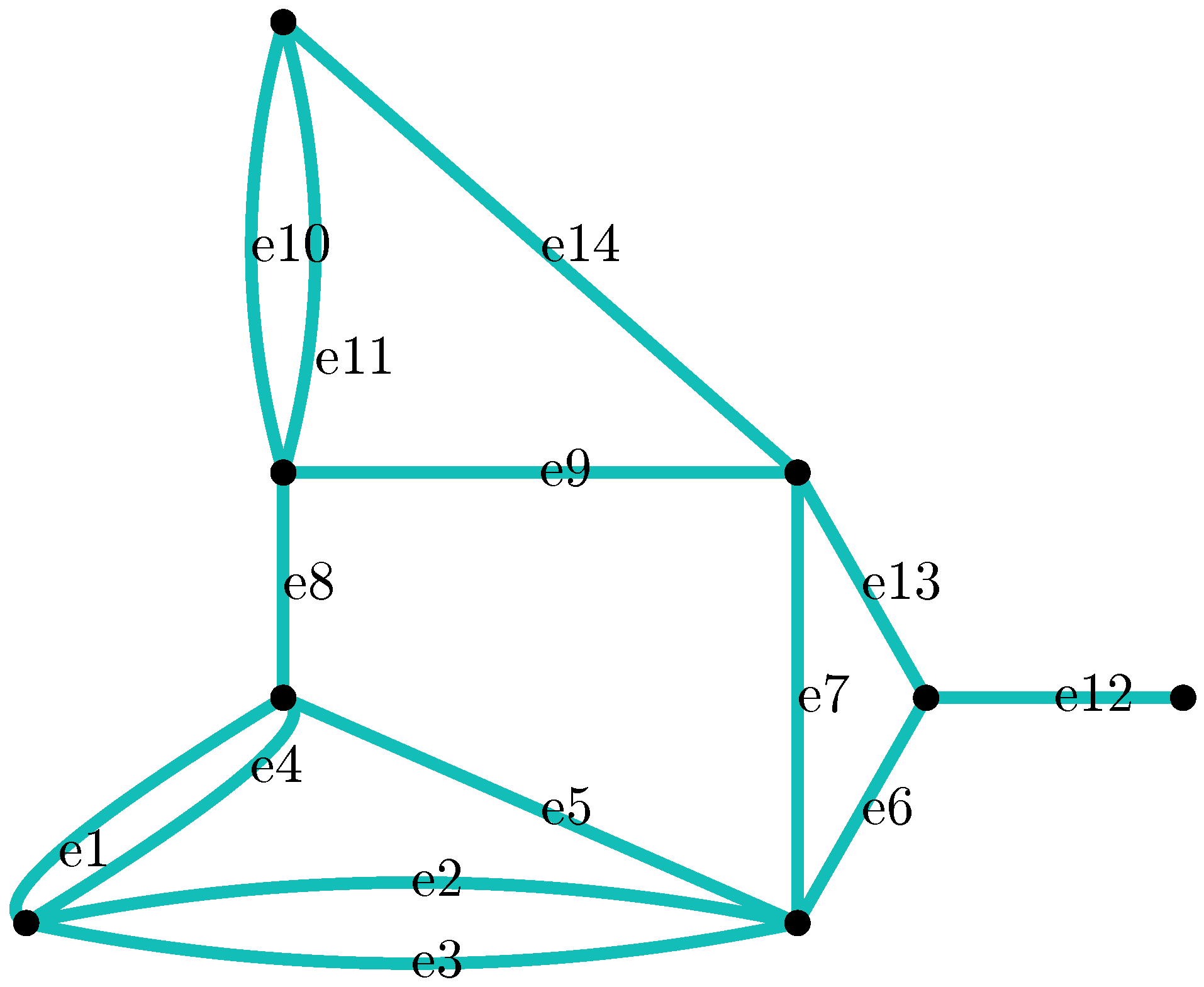
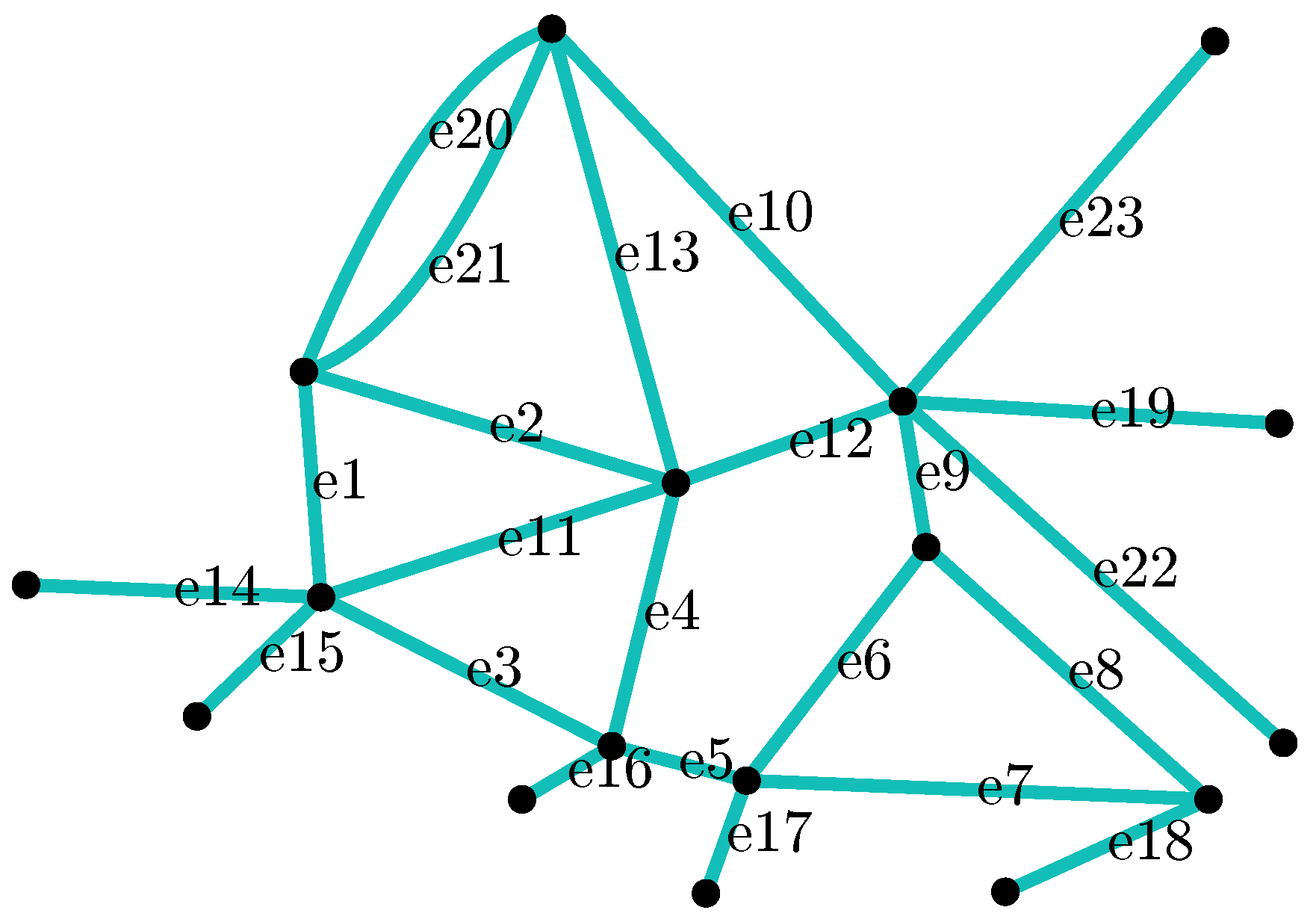
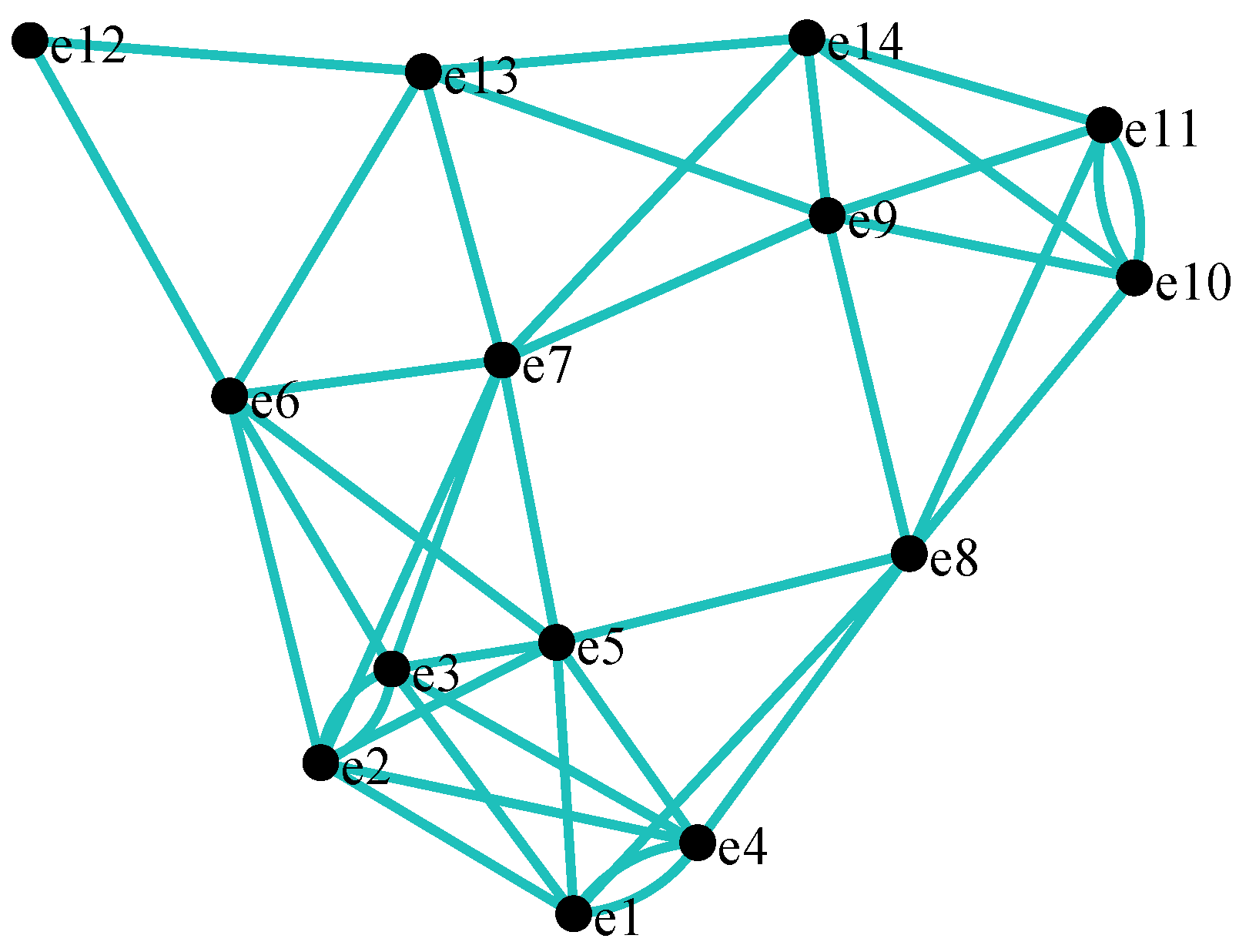
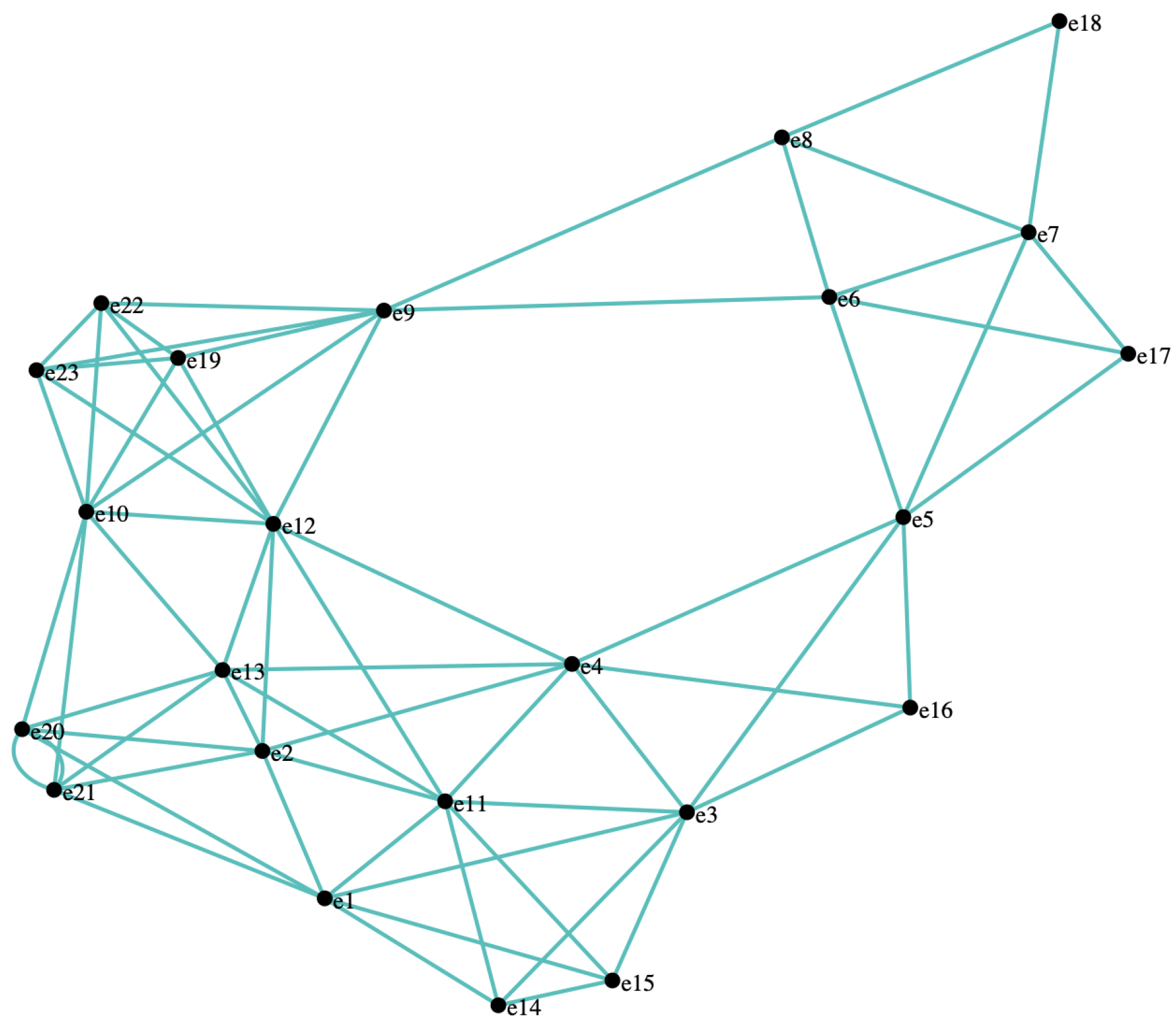
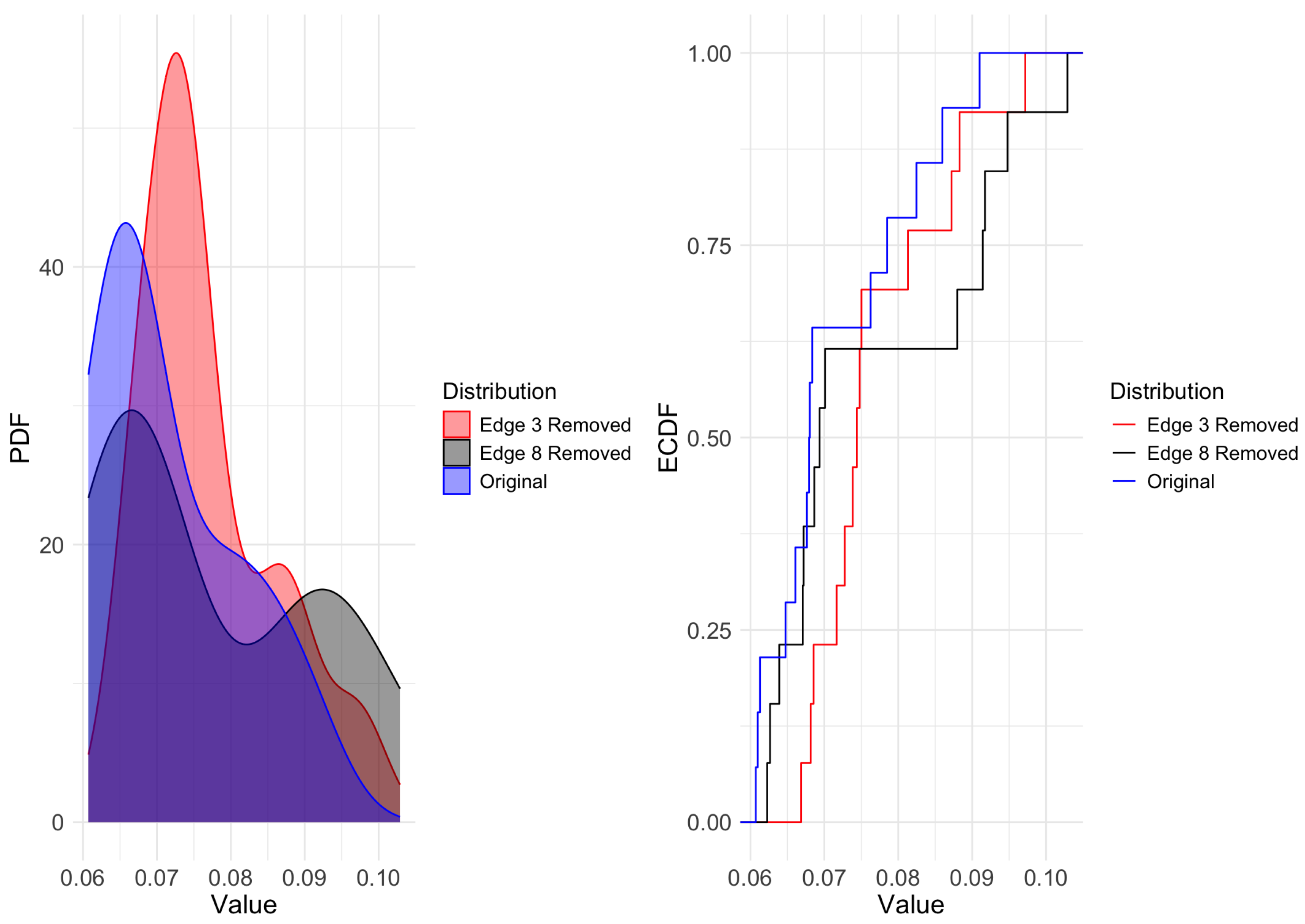
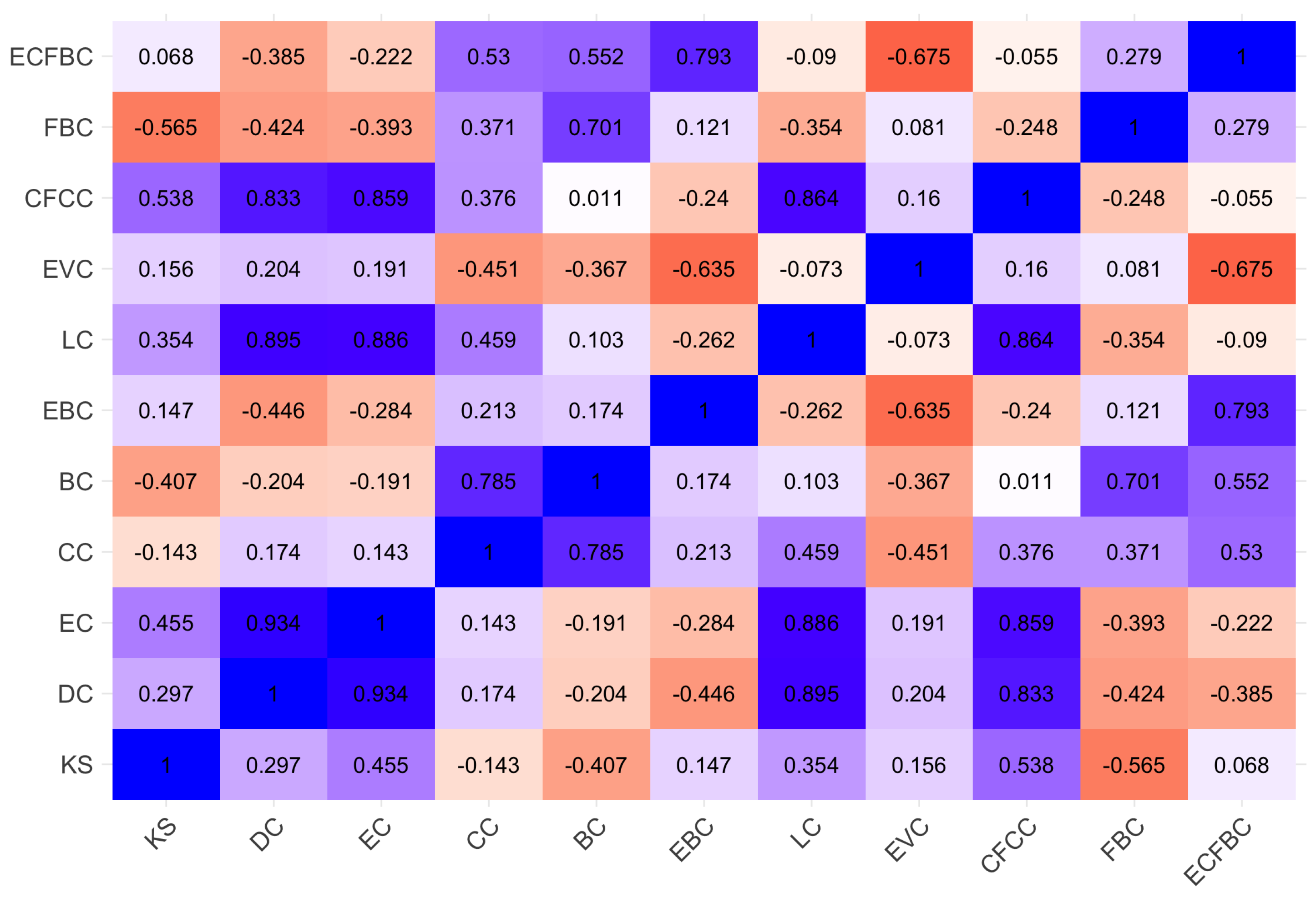
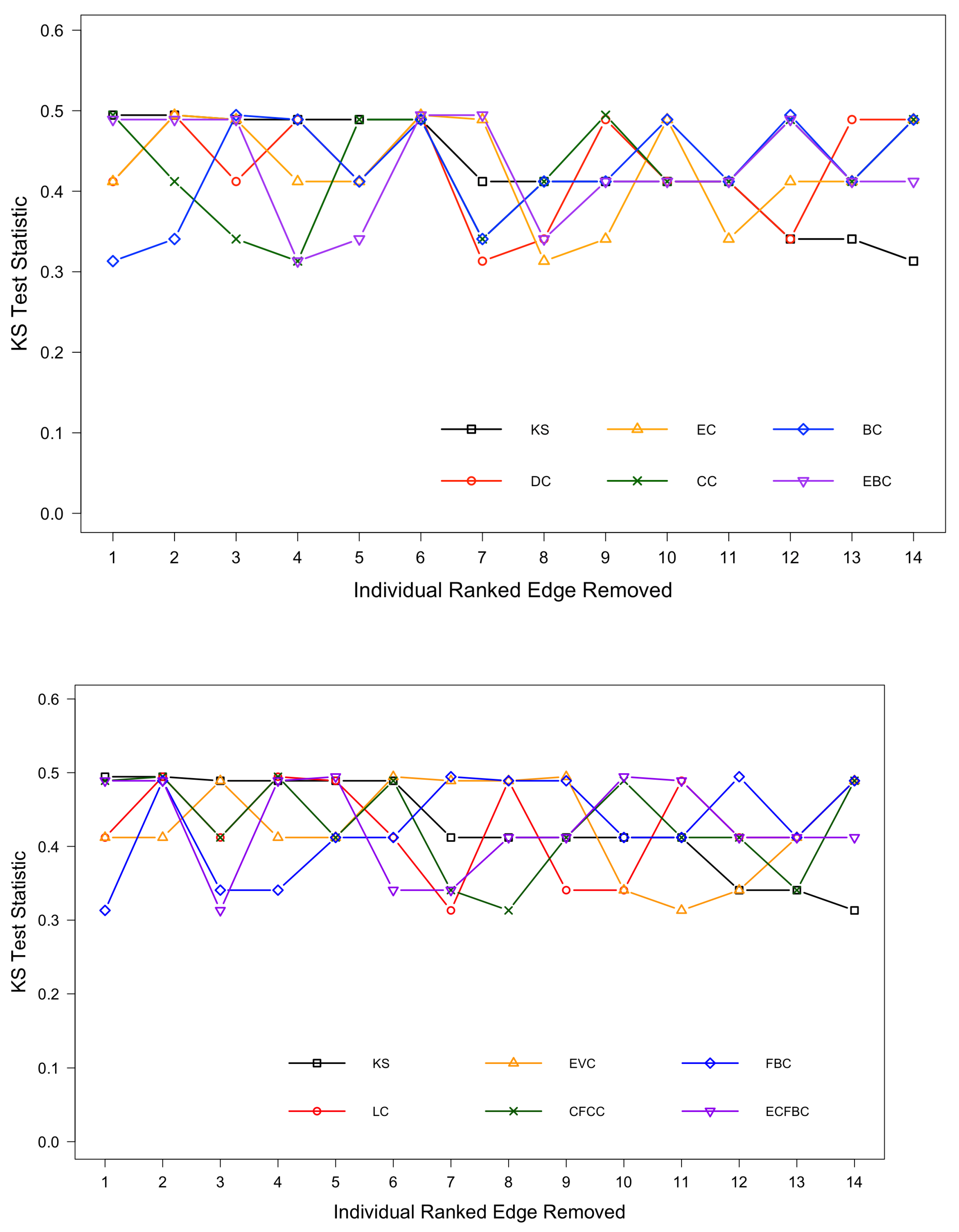
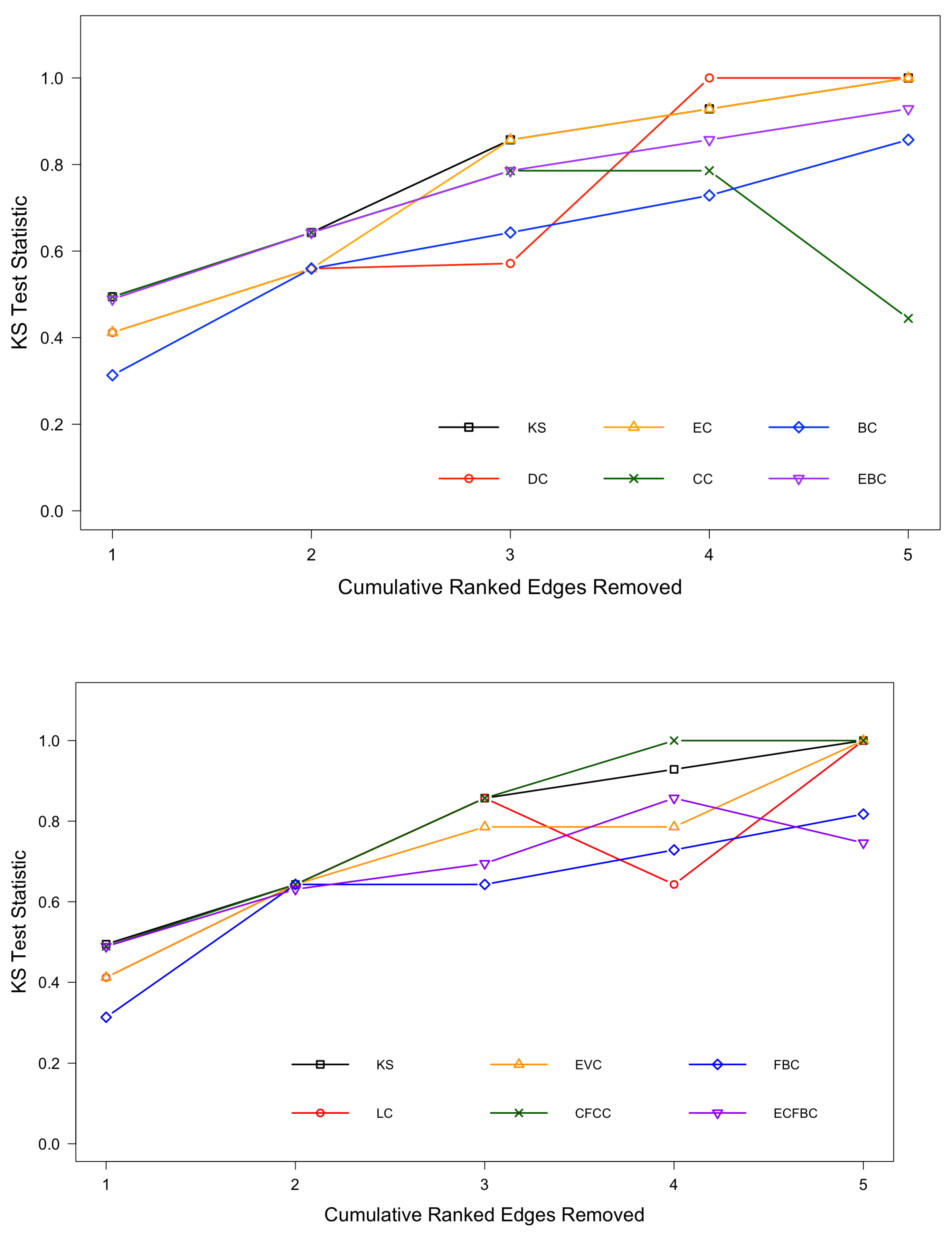
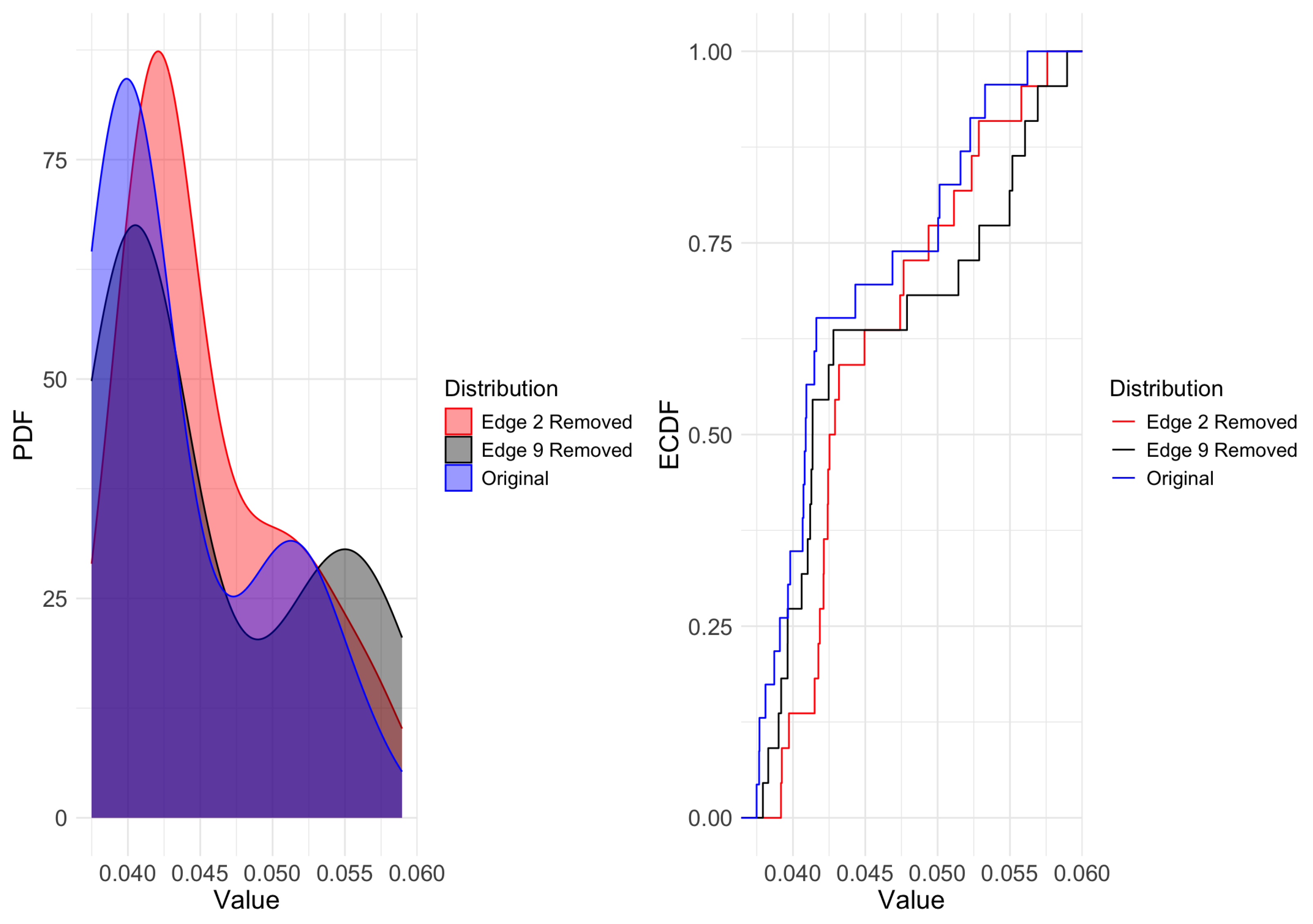
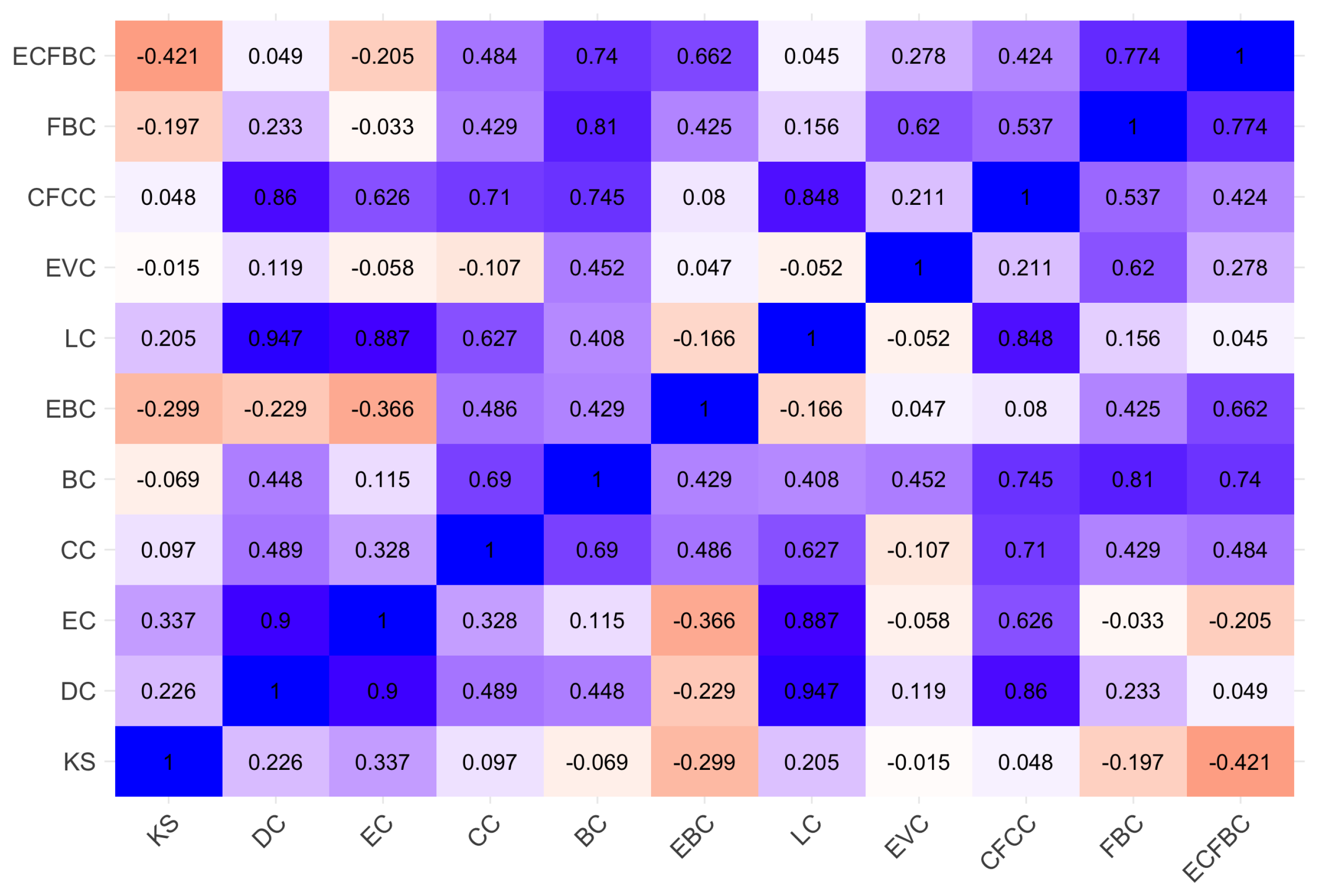
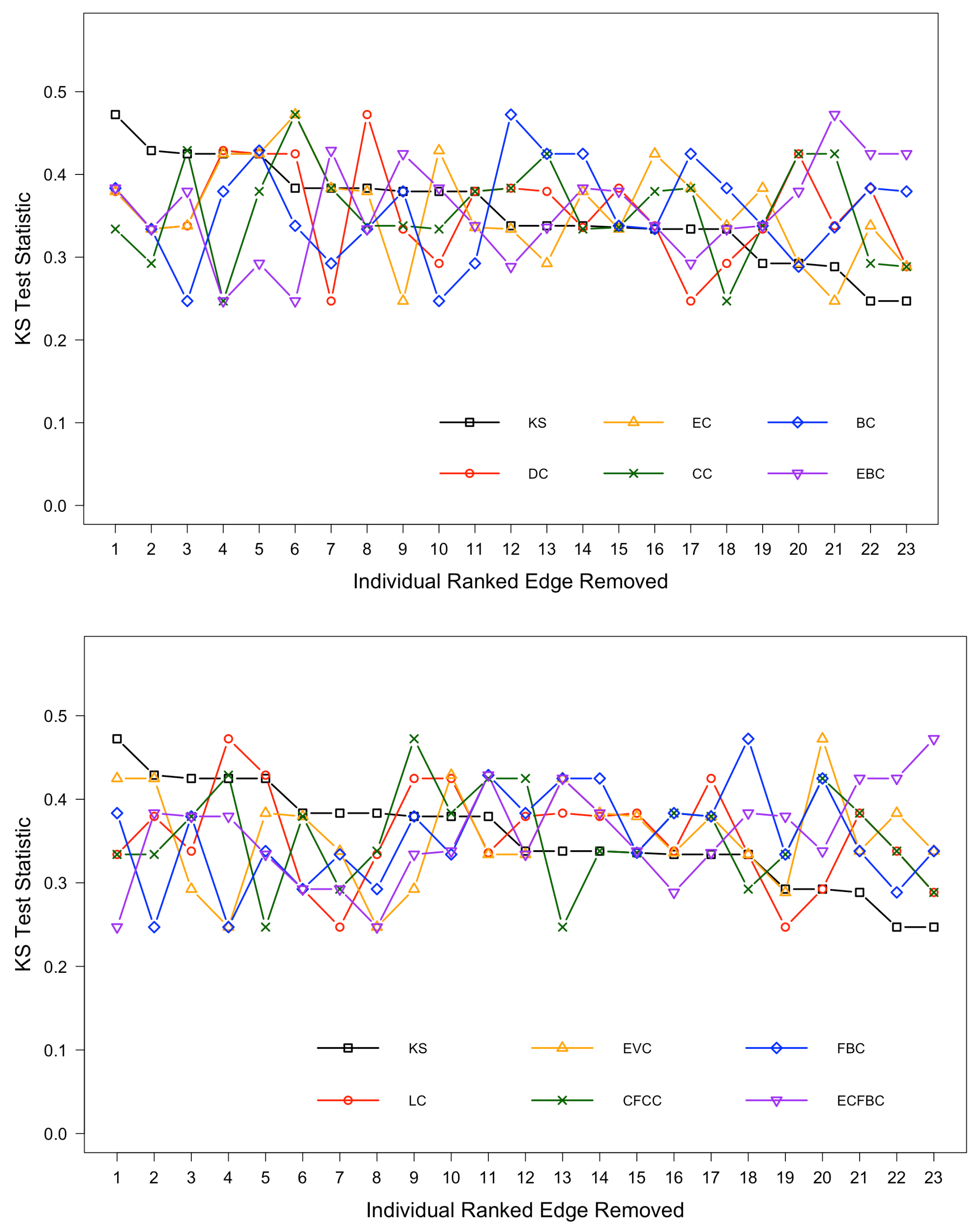
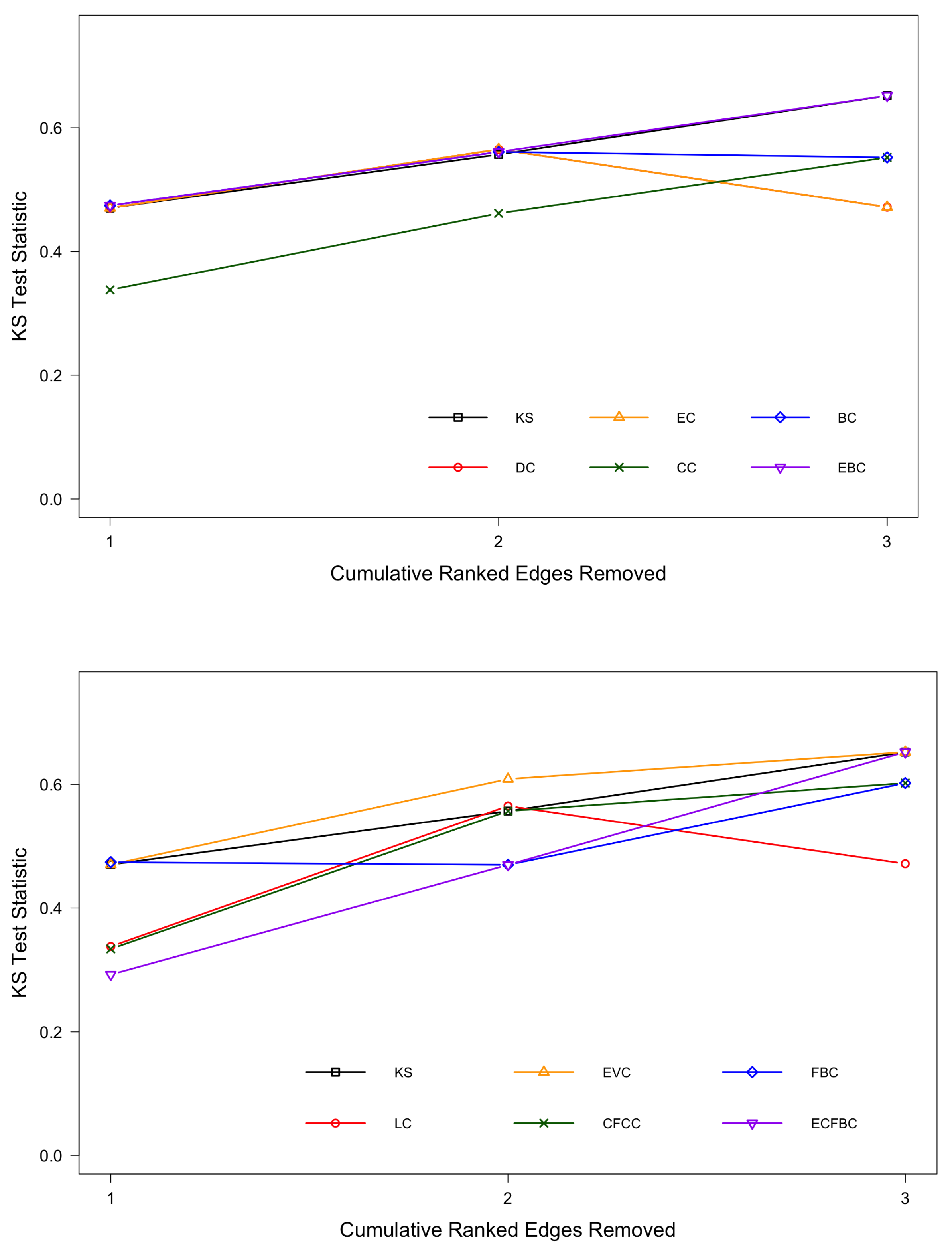
| Edge | |||||
| Adjacent Vertices | |||||
| Length | 11.91 | 7.08 | 6.00 | 2.24 | 4.12 |
| Edge | |||||
| Adjacent Vertices | |||||
| Length | 1.41 | 2.00 | 1.00 | 4.72 | 4.47 |
| Edge | |||||
| Adjacent Vertices | |||||
| Length | 2.00 | 2.00 | 1.41 | 4.47 |
| Edge | |||||
| KS -value | |||||
| Degree | |||||
| Eigenvector | |||||
| Closeness | |||||
| Betweenness | |||||
| Edge Betweenness | |||||
| Laplacian | |||||
| Entropy Variation | 0.083 | 0.066 | 0.066 | 0.083 | 0.001 |
| Current-Flow Closeness | |||||
| Flow Betweenness | |||||
| Edge Current-Flow Betweenness | |||||
| Edge | |||||
| KS -value | |||||
| Degree | |||||
| Eigenvector | |||||
| Closeness | |||||
| Betweenness | |||||
| Edge Betweenness | |||||
| Laplacian | |||||
| Entropy Variation | 0.016 | 0.003 | 0.002 | 0.003 | 0.105 |
| Current-Flow Closeness | |||||
| Flow Betweenness | |||||
| Edge Current-Flow Betweenness | |||||
| Edge | |||||
| KS -value | |||||
| Degree | |||||
| Eigenvector | |||||
| Closeness | |||||
| Betweenness | |||||
| Edge Betweenness | |||||
| Laplacian | |||||
| Entropy Variation | 0.105 | 0.001 | 0.019 | 0.002 | |
| Current-Flow Closeness | |||||
| Flow Betweenness | |||||
| Edge Current-Flow Betweenness |
| Centrality Measure | Top Five Ranked Edges |
|---|---|
| KS (Proposed) | 3, 7, 1, 6, 12 |
| Degree | 2, 3, 5, 1, 4 |
| Eigenvector | 2, 3, 1, 4, 5 |
| Closeness | 7, 5, 9, 8, 6 |
| Betweenness | 8, 14, 7, 13, 5 |
| Edge Betweenness | 12, 6, 13, 8, 9 |
| Laplacian | 5, 7, 2, 3, 1 |
| Entropy Variation | 10, 11, 1, 4, 2 |
| Current-Flow Closeness | 1, 7, 2, 3, 5 |
| Flow Betweenness | 8, 13, 9, 14, 10 |
| Edge Current-Flow Betweenness | 6, 13, 8, 12, 7 |
| Edge | |||||
| Adjacent Vertices | |||||
| Length | 1.00 | 1.00 | 1.69 | 1.71 | 0.69 |
| Edge | |||||
| Adjacent Vertices | |||||
| Length | 1.72 | 2.25 | 2.11 | 0.93 | 2.86 |
| Edge | |||||
| Adjacent Vertices | |||||
| Length | 1.00 | 1.18 | 2.95 | 1.40 | 0.96 |
| Edge | |||||
| Adjacent Vertices | |||||
| Length | 0.56 | 0.75 | 1.16 | 1.75 | 5.34 |
| Edge | |||||
| Adjacent Vertices | |||||
| Length | 2.46 | 2.82 | 2.70 |
| Edge | ||||||
| KS -value | 0.124 | 0.007 | 0.056 | 0.224 | 0.047 | 0.110 |
| Degree | 0.293 | 0.306 | 0.275 | 0.287 | 0.232 | 0.202 |
| Eigenvector | 0.549 | 0.766 | 0.308 | 0.523 | 0.154 | 0.129 |
| Closeness | 0.510 | 0.559 | 0.560 | 0.619 | 0.559 | 0.515 |
| Betweenness | 16.000 | 4.000 | 35.000 | 20.000 | 50.000 | 25.000 |
| Edge Betweenness | 9.000 | 6.000 | 27.000 | 18.000 | 35.000 | 15.000 |
| Laplacian | 4.055 | 4.943 | 3.458 | 4.347 | 2.683 | 2.294 |
| Entropy Variation | 0.006 | 0.001 | 0.012 | 0.008 | 0.014 | 0.012 |
| Current-Flow Closeness | 4.896 | 2.940 | 2.941 | 2.941 | 2.758 | 2.535 |
| Flow Betweenness | 67.000 | 37.000 | 109.000 | 79.000 | 197.000 | 92.000 |
| Edge Current-Flow Betweenness | 11.147 | 5.065 | 14.157 | 12.186 | 18.996 | 9.884 |
| Edge | ||||||
| KS -value | 0.408 | 0.224 | 0.408 | 0.056 | 0.018 | 0.124 |
| Degree | 0.202 | 0.165 | 0.309 | 0.405 | 0.316 | 0.405 |
| Eigenvector | 0.061 | 0.110 | 0.589 | 1.000 | 0.585 | 0.923 |
| Closeness | 0.456 | 0.442 | 0.561 | 0.506 | 0.584 | 0.624 |
| Betweenness | 12.000 | 8.000 | 36.000 | 14.000 | 32.000 | 44.000 |
| Edge Betweenness | 18.000 | 12.000 | 25.000 | 7.000 | 18.000 | 30.000 |
| Laplacian | 1.840 | 1.781 | 4.216 | 5.396 | 4.845 | 5.950 |
| Entropy Variation | 0.023 | 0.026 | 0.009 | 0.003 | 0.007 | 0.002 |
| Current-Flow Closeness | 2.537 | 2.262 | 2.942 | 3.098 | 3.095 | 3.229 |
| Flow Betweenness | 93.000 | 92.000 | 143.000 | 78.000 | 60.000 | 84.000 |
| Edge Current-Flow Betweenness | 11.672 | 11.782 | 20.068 | 14.853 | 9.574 | 13.674 |
| Edge | ||||||
| KS -value | 0.110 | 0.124 | 0.022 | 0.047 | 0.110 | 0.246 |
| Degree | 0.339 | 0.156 | 0.154 | 0.116 | 0.118 | 0.082 |
| Eigenvector | 0.898 | 0.213 | 0.211 | 0.127 | 0.045 | 0.023 |
| Closeness | 0.533 | 0.476 | 0.479 | 0.493 | 0.444 | 0.367 |
| Betweenness | 0.000 | 0.000 | 0.000 | 0.000 | 0.000 | 0.000 |
| Edge Betweenness | 8.000 | 16.000 | 16.000 | 16.000 | 16.000 | 16.000 |
| Laplacian | 5.156 | 2.256 | 2.257 | 1.717 | 1.403 | 0.822 |
| Entropy Variation | 0.001 | 0.006 | 0.006 | 0.001 | 0.001 | 0.002 |
| Current-Flow Closeness | 2.941 | 2.260 | 2.260 | 1.916 | 1.916 | 1.469 |
| Flow Betweenness | 33.000 | 35.000 | 35.000 | 57.000 | 31.000 | 35.000 |
| Edge Current-Flow Betweenness | 6.705 | 8.000 | 8.000 | 8.000 | 8.000 | 8.000 |
| Edge | ||||||
| KS -value | 0.117 | 0.022 | 0.022 | 0.047 | 0.056 | |
| Degree | 0.237 | 0.316 | 0.316 | 0.248 | 0.244 | |
| Eigenvector | 0.585 | 0.871 | 0.871 | 0.608 | 0.599 | |
| Closeness | 0.476 | 0.444 | 0.444 | 0.464 | 0.469 | |
| Betweenness | 0.000 | 0.500 | 0.500 | 0.000 | 0.000 | |
| Edge Betweenness | 16.000 | 0.000 | 1.000 | 16.000 | 16.000 | |
| Laplacian | 3.515 | 3.732 | 3.732 | 3.509 | 3.511 | |
| Entropy Variation | 0.004 | 0.084 | 0.084 | 0.005 | 0.005 | |
| Current-Flow Closeness | 2.535 | 2.756 | 2.756 | 2.535 | 2.535 | |
| Flow Betweenness | 39.000 | 47.000 | 47.000 | 39.000 | 39.000 | |
| Edge Current-Flow Betweenness | 8.000 | 6.598 | 6.254 | 8.000 | 8.000 |
| Centrality Measure | Top Three Ranked Edges |
|---|---|
| KS (Proposed) | 2, 11, 15 |
| Degree | 10, 12, 13 |
| Eigenvector | 10, 12, 13 |
| Closeness | 12, 4, 11 |
| Betweenness | 5, 12, 9 |
| Edge Betweenness | 5, 12, 3 |
| Laplacian | 12, 10, 13 |
| Entropy Variation | 20, 21, 8 |
| Current-Flow Closeness | 1, 12, 10 |
| Flow Betweenness | 5, 9, 3 |
| Edge Current-Flow Betweenness | 9, 5, 10 |
Disclaimer/Publisher’s Note: The statements, opinions and data contained in all publications are solely those of the individual author(s) and contributor(s) and not of MDPI and/or the editor(s). MDPI and/or the editor(s) disclaim responsibility for any injury to people or property resulting from any ideas, methods, instructions or products referred to in the content. |
© 2025 by the authors. Licensee MDPI, Basel, Switzerland. This article is an open access article distributed under the terms and conditions of the Creative Commons Attribution (CC BY) license (https://creativecommons.org/licenses/by/4.0/).
Share and Cite
Durón, C.; Kravitz, H.; Brio, M. Kolmogorov–Smirnov-Based Edge Centrality Measure for Metric Graphs. Dynamics 2025, 5, 16. https://doi.org/10.3390/dynamics5020016
Durón C, Kravitz H, Brio M. Kolmogorov–Smirnov-Based Edge Centrality Measure for Metric Graphs. Dynamics. 2025; 5(2):16. https://doi.org/10.3390/dynamics5020016
Chicago/Turabian StyleDurón, Christina, Hannah Kravitz, and Moysey Brio. 2025. "Kolmogorov–Smirnov-Based Edge Centrality Measure for Metric Graphs" Dynamics 5, no. 2: 16. https://doi.org/10.3390/dynamics5020016
APA StyleDurón, C., Kravitz, H., & Brio, M. (2025). Kolmogorov–Smirnov-Based Edge Centrality Measure for Metric Graphs. Dynamics, 5(2), 16. https://doi.org/10.3390/dynamics5020016






